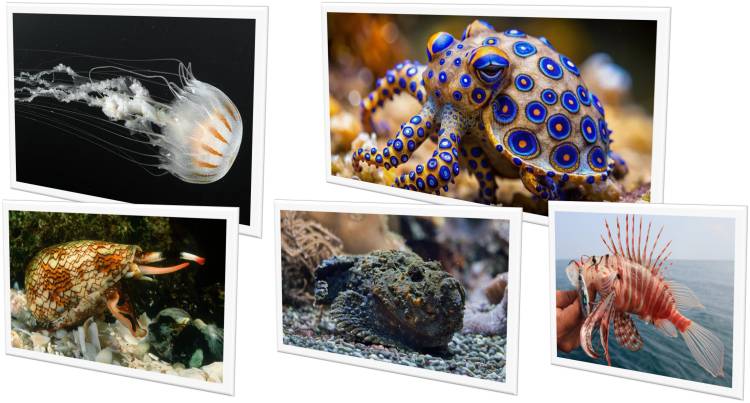
The World's 5 Most Dangerous Sea Creatures-P1
The World's 5 Most Dangerous Sea Creatures-P1
Here's a list of 6 of the most dangerous sea beings in the world, known for their venom, violence, strength, or other deadly traits. Some are unsafe to humans, others dominate their environments in terrifying ways:
Table of Contents
The World's 5 Most Dangerous Sea Creatures. 1
What Happens When You're Bitten: 5
Poisonous Killers
1:-Box Jellyfish:
Extremely venomous; wounds can reason cardiac arrest in minutes.
Box Jellyfish (Chironex fleckeri)
Nickname: “Sea Wasp”
Habitat:
- Warm coastal waters of the Indo-Pacific region and northern Australia.
- Often found near beaches, estuaries, and mangrove swamps during warmer months.
Why It’s Dangerous:
- World’s most toxic marine sea animal.
- Its sting can kill a human in under 5 minutes.
- Responsible for dozens of known deaths in Australia alone, and potentially many more unreported across Asia.
Spite Effects:
- The venom attacks the heart, nervous system, and skin.
- Causes:
- Excruciating pain
- Cardiac arrest
- Respiratory failure
- Skin mortification (tissue death)
- “Irukandji syndrome” in some cases (intense muscle cramps, anxiety, and hypertension)
Survival Window:
- Immediate first aid is crucial.
- Vinegar (acetic acid) can help deactivate undischarged stingers.
- CPR and antivenom are needed AS SOON AS POSSIBLE(ASAP).
- Victims often die from shock or heart failure before reaching help.
Entrance:
- Almost invisible in the water — transparent and pale blue.
- Has a cube-shaped bell (why it's called "box" jellyfish).
- Bell size: up to 30 cm (12 inches) across.
- Tentacles: Up to 3 meters (10 feet) long, each covered in millions of nematocysts (stinging cells).
Fun but Scary Fact:
- Unlike most jellyfish, Box Jellyfish can see.
- They have 24 eyes, grouped in clusters, and are capable of active hunting rather than just drifting.
- This makes them strategic swimmers — they avoid obstacles and pursue prey.
Species Variety:
- Over 50 species of box jellyfish exist.
- Chironex fleckeri is the most lethal, but Carukia barnesi (a smaller species) causes Irukandji syndrome.
Safety Tips:
- Wear protective stinger suits when swimming in known danger zones.
- Observe warning signs on beaches.
- Do not swim during box jellyfish season (typically October to May in Northern Australia).
- If stung:
- Pour vinegar immediately.
- Remove tentacles with tweezers (wear gloves if possible).
- Call emergency services.
2: -Blue-Ringed Octopus
(Tiny but deadly; carries enough venom to kill 26 adults)
Here’s a detailed look at one of the most illusorily beautiful and dangerously toxic creatures in the sea:
Blue-Ringed Octopus (Genus: Hapalochlaena)
Nickname: “The deadly gem of the sea”
Habitat:
- Found in tide pools and coral reefs across:
- Australia
- Japan
- Indonesia
- Philippines
- Western Pacific Ocean
- Typically hides under rocks, shells, or debris during the day and hunts at night.
Venom & Danger Level:
- Extremely venomous — among the most lethal animals on Earth.
- Contains tetrodotoxin (TTX), a powerful neurotoxin.
- 1 milligram of this toxin can kill a human, and there's no known antivenom.
What Happens When You're Bitten:
- Bite is often painless and may go unnoticed at first.
- Symptoms develop within minutes:
- Numbness around the mouth
- Difficulty breathing
- Muscle paralysis
- Vision loss or blindness
- Nausea
- Respiratory disappointment
- Victims may appear conscious but paralysed, often referred to as “locked-in syndrome.”
Time to death: As little as 30 minutes if untreated.
Appearance:
- Small: Only about 5–8 cm (2–3 inches) in length.
- Yellowish or tan body with electric blue rings (which flash when it feels threatened).
- The rings are a warning display, not always visible when calm.
Fun but Terrifying Facts:
- It’s not aggressive — it bites only when motivated or handled.
- Carries enough venom to kill 20–26 adult humans.
- The toxin it produces is the same found in pufferfish and some newts.
Classes of Note:
There are four known species, with the Greater Blue-Ringed Octopus (Hapalochlaena lunulata) being the most well-known.
Care Tips:
- NEVER pick up or touch any octopus in the wild, especially small, colorful ones.
- Keep children and pets away from tide pools where they may hide.
- If bitten:
- Apply weight immobilization technique.
- Provide saving breathing or CPR if breathing stops.
- Get extra medical attention immediately.
3: -Cone Snail
(Beautiful shell, but a single sting can be lethal)
Here's a deep dive into the Cone Snail, one of the ocean's most unexpected killers:
Cone Snail (Genus: Conus)
Nickname: "Cigarette Snail"
- as “you’ll only have time for one cigarette” after a sting, before death could occur (legend, but chillingly symbolic).
Environment:
- Found in warm tropical and subtropical waters:
- Indo-Pacific area
- Red Sea
- Indian Ocean
- Caribbean
- Northern Australia
- Hides in sandy seafloors, coral reefs, and shallow tide pools.
Appearance:
- Beautiful, often colorful, cone-shaped shell — looks harmless and collectible.
- Size: from 2 cm to 15+ cm (1–6 inches) long, depending on species.
- Smooth and patterned shells are often highly prized by shell collectors — which adds to the danger.
Why It’s Dangerous:
- Venomous harpoon-like tooth (radula) hidden inside its mouth.
- Used to stab and paralyse prey within milliseconds.
- Venom contains conotoxins, a complex cocktail that targets the nervous system.
- Can cause:
- Paralysis
- Respiratory failure
- Muscle shutdown
- Vision problems
- Death (in extreme cases)
No antivenom exists.
Unlike snakebites or jellyfish stings, there is currently no known antivenom for pinecone snail envenomation.
Here's why:
1. Complex Venom
- Cone snail venom covers dozens to hundreds of different conotoxins (each species has its own unique cocktail).
- These toxins target different parts of the nervous system, including:
- Sodium channels
- Calcium channels
- Potassium channels
- Neurotransmitter receptors
This makes creating a universal antivenom nearly impossible with current medicine.
2. Fast-Acting & Potent
- The venom can paralyze respiratory muscles in minutes.
- Victims may remain conscious but unable to move or breathe, a state similar to being “locked in.”
Treatment Attentions on Helpful Care:
Since there's no antivenom, treatment involves keeping the person alive long enough for the toxins to wear off:
- Call emergency services immediately.
- Keep the victim calm and still — movement increases venom spread.
- Immobilize the affected limb with a pressure bandage.
- Begin CPR or rescue breathing if breathing stops.
- In hospital: the victim may need to be put on a ventilator for hours or days until the venom is metabolized.
"Cigarette" Malice Potency:
- Only some species are deadly to humans — especially Conus geographus (Geography Cone) and Conus textile.
- The venom is so powerful that it’s being researched for use in non-opioid painkillers — that’s how potent and targeted it is.
How it Hunts:
- Lies in wait for prey (worms, fish, or small molluscs).
- Detects movement, then fires a hollow harpoon projection loaded with venom.
- Once paralysed, the prey is wound in and swallowed whole.
Indications of a Bite:
- Localized pain, swelling, and numbness.
- Progression to:
- Muscle paralysis
- Trouble speaking or breathing
- Blurred vision
- Total body shutdown (in severe cases)
- Death can occur within a few hours in rare but documented cases.
Care Tips:
- NEVER handle live cone snails, even if they look empty or dead.
- Especially avoid picking up shells in unfamiliar tide pools or reef areas.
- If smarted:
- Immobilize the area.
- Apply pressure to reduce venom spread.
- Get medical help immediately — supportive care (like artificial ventilation) may be necessary.
Isolated Fact:
- Despite their risk, cone snails are very slow-moving.
- Their deadly efficiency comes not from speed but from chemical warfare.
4: -Stonefish
(Camouflaged and venomous; stepping on one can be deadly)
Oh, you're going for the real ocean nightmares — and the Stonefish definitely earns its title. Here’s everything you need to know:
Stonefish (Genus: Synanceia)
Nickname: “The World’s Most Venomous Fish”
Habitat:
- Found in coastal regions of the Indo-Pacific, including:
- Australia
- Indonesia
- Red Sea
- Parts of the Pacific Islands
- Lives in shallow waters, often in coral reefs, estuaries, and tide pools.
- Likes to bury itself in sand or camouflage on rocks.
Camouflage Master:
- Resembles a rock or lump of coral, making it almost impossible to see.
- Warty skin and uneven texture help it blend perfectly.
- This is why most injuries happen to people who step on it by accident.
Why It’s Dangerous:
- Has 13 razor-sharp dorsal spines, each connected to venom glands.
- When pressure is applied (e.g., someone steps on it), it injects venom through these spines.
- Venom is highly toxic and causes:
- Intense, burning pain (described as “the worst pain known to man”)
- Swelling and tissue death
- Shock and paralysis
- Heart failure in extreme cases
Without treatment, death can occur in a few hours — particularly in children or elderly individuals.
Symptoms of a Sting:
- Immediate, excruciating pain
- Rapid swelling
- Nausea, vomiting, and difficulty breathing
- Muscle weakness or paralysis
- Loss of consciousness in severe cases
Is There Antivenom?
Yes!
- Antivenom is available, especially in Australia where stings are most common.
- Hot water immersion (to break down the protein-based venom) is often used as first aid — immerse the affected limb in hot water (~45°C / 113°F) for 30–90 minutes.
Safety Tips:
- Wear thick-soled water shoes when walking in shallow, rocky areas.
- Don't touch or disturb rocks underwater.
- If stung:
- Apply hot water to the area.
- Immobilize the limb.
- Get to a hospital immediately for pain management and antivenom.
Cool but creepy fact:
- Stonefish can survive out of water for 24+ hours thanks to a special respiratory system, meaning they can be dangerous even on dry rocks at low tide.
5: -Lionfish
(Striking spines with painful venom; invasive and dangerous)
Lionfish (Genus: Pterois)
Nickname: “The Beautiful Menace”
Habitat:
- Native to the Indo-Pacific region.
- Invasive in the Atlantic Ocean, Caribbean Sea, and Gulf of Mexico — with no natural predators in these areas.
- Found on coral reefs, seagrass beds, and rocky crevices from shallow waters to 300 feet deep.
Appearance:
- Striking zebra-like pattern with red, white, and brown stripes.
- Elegant, feathery pectoral fins and long, venomous dorsal spines.
- Average size: 30–40 cm (12–16 inches).
Despite their beauty, they’re deadly to smaller fish — and painfully dangerous to humans.
Why It’s Dangerous:
- Has 18 venomous spines:
- 13 dorsal
- 2 pelvic
- 3 anal
- Spines are used defensively, not offensively — they sting when stepped on or mishandled.
- Venom causes:
- Intense localized pain
- Swelling, redness
- Headaches, nausea
- Muscle weakness or even temporary paralysis
- Rarely fatal, but extremely painful.
Venom Effects:
- Similar to snake venom: protein-based and affects the nervous system.
- Venom is heat-labile — meaning it breaks down in heat (which is key for first aid).
First Aid for a Sting:
- Immerse the affected area in hot water (not scalding, but as hot as tolerable) for 30–90 minutes.
- Clean the wound to prevent secondary infection.
- Remove any visible spines with tweezers.
- Seek medical attention — especially if symptoms worsen or allergic reaction occurs.
Invasive Threat:
- In the Atlantic and Caribbean, lionfish have become a major ecological threat.
- They eat up to 90% of juvenile reef fish in some areas.
- Can decimate reef ecosystems due to unchecked reproduction and hunger.
- Females lay up to 2 million eggs per year
Edible: and Delicious!
- Their flesh is non-venomous and safe to eat.
- In fact, many regions encourage lionfish hunting as a method of population control.
- It’s a sustainable seafood choice where they’re invasive — tasty and eco-friendly!
Safety Tips:
- Never handle lionfish without protective gloves or tools.
- Divers: use specialized spears or containers to collect them.
- Beachgoers: avoid moving washed-up lionfish — dead ones can still sting.



















